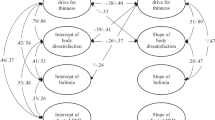Abstract
Puberty has been related to the onset of a variety of weight concerns and eating problems among middle school girls, including body dissatisfaction, dieting, and eating disorders. At least two models can be used to explain these relationships. The first emphasizes the timing of puberty, arguing that girls who face early puberty are particularly stressed because of the off-time nature of the event. The second focuses on synchronous events. For girls more than boys, puberty is likely to coincide with the change from elementary to middle school and/or beginning to date. Such synchronous events may create greater stress for girls. Seventy-nine girls were tested during the spring of their sixth- and eighth-grade years. Pubertal and dating status, body dissatisfaction, weight management, and eating disordered attitudes (using the Children's EAT:ChEAT) were assessed. The simple timing model (early vs. on time vs. late) was not supported. The simple synchronous model received some support in that girls with synchronous onset of menstruation and dating had higher ChEAT scores as well as greater body dissatisfaction. However, the data indicated that girls for whom puberty was early and coincidental with dating might be at unusual risk. These girls showed the highest levels of body dissatisfaction and the highest ChEAT scores.
Similar content being viewed by others
References
Attie, I., and Brooks-Gunn, J. (1987). Weight concerns as chronic Stressors in women. In Barnett, R., Biener, L., and Baruch, G. (eds.),Gender and Stress. Free Press, New York.
Attie, I., and Brooks-Gunn, J. (1989). Development of eating problems in adolescent girls: A longitudinal study.Develop. Psychol 25: 70–79.
Attie, I., and Brooks-Gunn, J. (1992). Developmental issues in the study of eating problems and disorders. In Crowther, J., Hobfoll, S., Stephens, M., and Tennenbaum, D. (eds.),The Etiology of Bulimia: The Individual and Familial Context. Hemisphere Publishers, Washington, DC.
Broderick, C., and Rowe, G. (1968). A scale of preadolescent heterosexual development.J. Marriage Family 30: 97–101.
Brooks-Gunn, J. (1987). Pubertal processes and girls' psychological adaptation. In Lerner, R., and Foch, T. (eds.),Biological-Psychosocial Interactions in Early Adolescence. Erlbaum, Hillsdale, NJ.
Brooks-Gunn, J., and Warren, M. (1988). The psychological significance of secondary sexual characteristics in nine-to-eleven-year-old girls.Child Develop. 59: 1061–1069.
Cohn, L., Adler, N., Irwin, C., Millstein, S., Klesges, S., and Stone, G. (1987). Body-figure preferences in male and female adolescents.J. Abnormal Psychol. 96: 276–279.
Crisp, A. (1980).Anorexia Nervosa: Let Me Be. Grune & Stratton, New York.
Damhorst, M., Littrell, J., and Littrell, M. (1988). Age differences in adolescent body satisfaction.J. Psychol. 121: 553–562.
Fabian, L., and Thompson, J. K. (1989). Body image and eating disturbance in young females.International J. Eat. Disord. 8: 63–74.
Fallon, A. (1990). Culture in the mirror: Sociocultural determinants of body image. In Cash, T., and Pruzinsky, T. (eds.),Body images: Development, Deviance, and Change. Guilford, New York.
Garner, D., Olmstead, M., Bohr, Y., and Garfinkel, P. (1982). The Eating Attitudes Test: Psychometric features and clinical correlates.Psychol. Med. 1: 273–279.
Gralen, S., Levine, M., Smolak, L., and Murnen, S. (1990). Dieting and disordered eating during early and middle adolescence: Do the influences remain the same?Int. J. Eat. Disord. 9: 501–512.
Herman, C. P., and Polivy, J. (1975). Anxiety, restraint, and eating behavior.J. Abnormal Psychol. 84: 666–672.
Hsu, L. K. G. (1990).Eating Disorders. Guilford, New York.
Levine, M. P. (1987).Student Eating Disorders: Anorexia Nervosa and Bulimia. National Education Association, Washington, DC.
Levine, M. P., and Smolak, L. (1992). Toward a developmental psychopathology of eating disorders. In Crowther, J., Hobfoll, S., Stephens, M., and Tennenbaum, D. (eds.),The Etiology of Bulimia: The Individual and Familial Contexts, Hemisphere Publishers, Washington, DC.
Lissner, L., Odell, P., D'Agostino, R., Stokes, J., Kreger, B., Belanger, A., and Brownell, K. (1991). Variability of body weight and health outcomes in the Framingham population.N. Engl. J. Med. 324: 1839–1844.
Magnusson, D., Stattin, H., and Allen, V. (1986). Differential maturation among girls and its relation to social adjustment: A longitudinal perspective. In Baltes, P., Featherman, D., and Lerner, R. (eds.).Life-Span Development and Behavior (Vol. 7). Erlbaum, Hillsdale, NJ.
Maloney, M., McGuire, J., and Daniels, S. (1988). Reliability testing of a children's version of the Eating Attitudes Test.J. Am. Acad. Child Adoles. Psychiat. 5: 541–543.
Maloney, M., McGuire, J., Daniels, S., and Specker, B. (1989). Dieting behavior and eating attitudes in children.Pediatrics 84: 482–489.
Paxton, S., Wertheim, E., Gibbons, K., Szmukler, G., Hillier, L., and Petrovich, J. (1991). Body image satisfaction, dieting beliefs, and weight loss behaviors in adolescent girls and boys.J. Youth Adolesc. 20: 361–379.
Polivy, J., and Herman, C. P. (1987). Diagnosis and treatment of normal eating.J. Consult. Clin. Psychol. 55: 635–644.
Rauste-von Wright, M. (1989). Body image satisfaction in adolescent girls and boys: A longitudinal study.J. Youth Adolesc. 18: 71–83.
Rodin, J., Silberstein, L., and Streigel-Moore, R. (1985). Women and weight: A normative discontent. In Sonderegger, T. (ed.),Nebraska symposium on motivation: Vol. 32. Psychology and gender. University of Nebraska Press, Lincoln.
Rosen, J., and Gross, J. (1987). Prevalence of weight reducing and weight gaining in adolescent girls and boys.Health Psychol. 6: 131–147.
Rosen, J., Silberg, N., and Gross, J. (1988). Eating Attitudes Test and Eating Disorders Inventory: Norms for adolescent girls and boys.J. Consult. Clin. Psychol. 56: 305–308.
Simmons, R., and Blyth, D. (1987).Moving into Adolescence: The Impact of Pubertal Change and School Context. Aldine, Hawthorne, NJ.
Simmons, R., Burgeson, R., Carlton-Ford, S., and Blyth, D. (1987). The impact of cumulative change in early adolescence.Child Develop. 58: 1220–1234.
Author information
Authors and Affiliations
Additional information
Ph.D. from Temple University. Research interest is in developmental psychology.
Ph.D. from the University of California at Santa Barbara
These authors have a joint research program in the developmental psychopathology of eating problems.
The first wave of data for this report was collected as part of her undergraduate honors thesis.
Rights and permissions
About this article
Cite this article
Smolak, L., Levine, M.P. & Gralen, S. The impact of puberty and dating on eating problems among middle school girls. J Youth Adolescence 22, 355–368 (1993). https://doi.org/10.1007/BF01537718
Received:
Accepted:
Issue Date:
DOI: https://doi.org/10.1007/BF01537718




